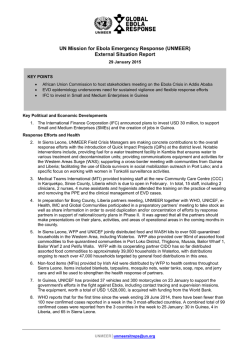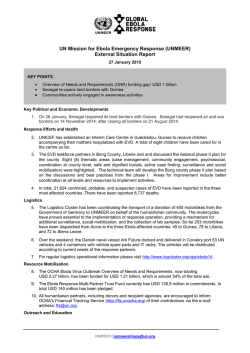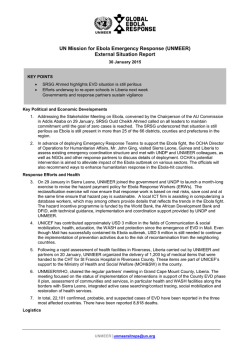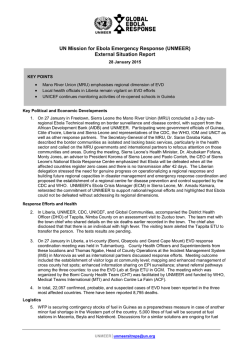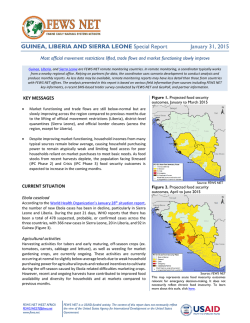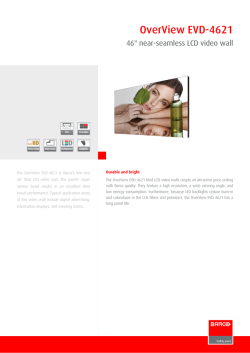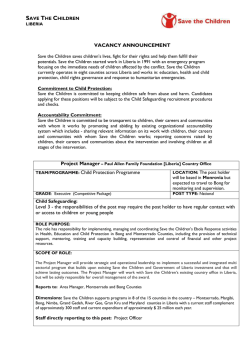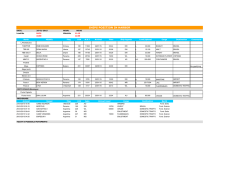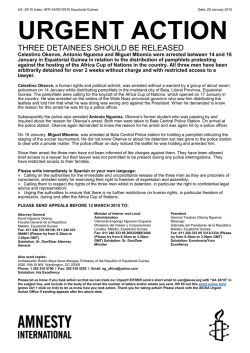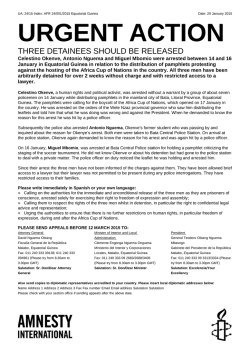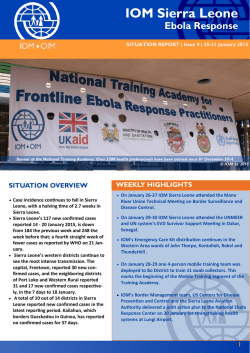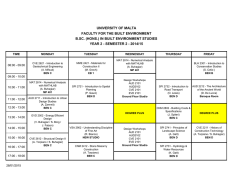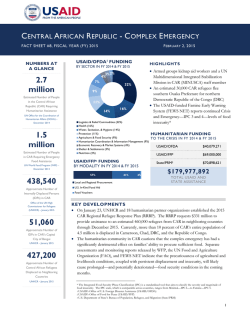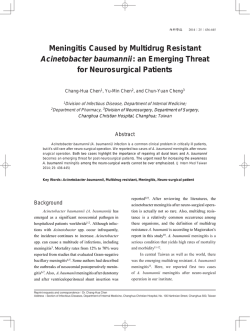
West Africa - Ebola Outbreak Fact Sheet #18
WEST AFRICA – EBOLA OUTBREAK FACT SHEET #18, FISCAL YEAR (FY) 2015 NUMBERS AT A GLANCE 22,057 Number of Suspected, Probable, and Confirmed Ebola Virus Disease (EVD) Cases in Acutely Affected Countries* UN World Health Organization (WHO) – January 28, 2015 8,795 Number of EVD-Related Deaths* WHO – January 28, 2015 10,518 Number of EVD Cases in Sierra Leone* WHO – January 28, 2015 8,622 Number of EVD Cases in Liberia* WHO – January 28, 2015 2,917 Number of EVD Cases in Guinea* WHO – January 28, 2015 *Includes cumulative EVD cases in Guinea, Liberia, and Sierra Leone. Numbers are subject to change due HIGHLIGHTS J ANUARY 28, 2015 USG HUMANITARIAN ASSISTANCE TO EVD OUTBREAK RESPONSE With support from the Government of TO DATE IN FY 2014 & FY 2015 Germany, a temporary unit for treating USAID/OFDA1 $451,117,862 non-EVD infections opened in Liberia’s capital city of Monrovia on January 23. USAID/FFP2 $43,739,529 The Government of Senegal (GoS) USAID/GH3 $17,676,000 reopened land border crossings with USAID/Liberia $5,000,000 Guinea on January 26. The GoS had closed all borders with Guinea on August USAID/Guinea $3,482,000 21 due to the EVD outbreak and DoD4 $326,000,000 previously reopened air and sea borders with Guinea on November 14. CDC5 $74,042,8596 As of January 26, the Government of Liberia (GoL) had reported a total of $921,058,250 21 confirmed cases in the last 21 days— USG ASSISTANCE TO THE WEST AFRICA eight cases from Grand Cape Mount EVD OUTBREAK RESPONSE 7 County and 13 from Montserrado County. KEY DEVELOPMENTS Non-governmental organization (NGO) Médecins Sans Frontières (MSF) is planning to reduce the number of beds at the ELWA Three EVD treatment unit (ETU) in Monrovia— the largest-ever ETU constructed—according to media. MSF plans to keep the site operational but reduce the current capacity from 60 beds to 30 beds by late February. The site housed as many as 120 beds when it opened in August 2014—at the time patient demand exceeded the ETU’s capacity. Highlighting the decline in cases, MSF reported having no patients in treatment at ELWA Three on January 17 for the first time since the site opened. MSF noted that while it was reducing the number of beds, it could scale the site up to 120 beds within a day, if needed. Representatives from Mano River Union (MRU) states—comprising Côte d'Ivoire, Guinea, Liberia, and Sierra Leone—and staff from CDC, the International Organization for Migration (IOM), the UN, and WHO met between January 26 and 27 to discuss border surveillance and disease control in Sierra Leone’s capital city of Freetown. The Secretary-General of the MRU called on the governments and international partners to focus attention on border communities, noting that many lacked basic health care services. The participants also reiterated the importance of reaching zero EVD cases in all affected countries. to reclassification, retrospective 1 investigation, and availability of 2 laboratory results. 3 USAID’s Office of U.S. Foreign Disaster Assistance (USAID/OFDA) USAID’s Office of Food for Peace (USAID/FFP) USAID’s Bureau for Global Health (USAID/GH) 4 U.S. Department of Defense (DoD) 5 U.S. Centers for Disease Control and Prevention (CDC) 6 CDC funding as of January 28, 2015; total includes estimated salaries, benefits, and funding from all CDC sources. USAID/OFDA funding to CDC of $3 million and DoD funding to CDC of $600,000 is not included in this total. 7 Total funding figures reflect committed U.S. Government (USG) humanitarian and development funding to date. This number represents a subset of the total USG effort. 1 CURRENT SITUATION Newly confirmed cases in Liberia remain at approximately one case per day—the Government of Liberia (GoL) reported 21 confirmed cases between January 5 and January 26. In Sierra Leone, new cases continue to decrease. The Government of Sierra Leone (GoSL) reported nine new cases on January 27 and 262 new cases in the two weeks between January 7 and 20—a marked decrease from the 869 new confirmed cases reported by the GoSL in the two weeks between November 18 and December 1. Between January 19 and 25, the Government of Guinea (GoG) reported 30 confirmed cases, representing a 50 percent increase from the 20 confirmed cases reported during the previous week—the first time in 2015 that the weekly number of new cases increased in Guinea, according to the UN. Liberia As health actors work with the GoL to restore non-EVD health care services, the Liberian Ministry of Health (MoH)— with support from the German Red Cross (DRK) and German army—opened a Severe Infection Temporary Treatment Unit (SITTU) on the Samuel K. Doe Stadium grounds in Monrovia on January 23 to temporarily fill a gap in infectious disease care. The SITTU is designed to accept patients with symptoms consistent with EVD but not yet confirmed—an important gap, given that much of the Liberian health system ceased providing non-EVD health services during the acute stages of the outbreak. The SITTU will accept both walk-ins and referrals from other health facilities. Once at the SITTU, patients who test positive for EVD will be transferred to an ETU; patients who test negative will be treated for other infectious diseases. Those with no symptoms will be transferred to a health facility. According to the DRK, the SITTU is intended to improve the level of clinical care for infectious non-EVD patients; reduce EVD exposure risk for non-EVD patients who may otherwise seek care at an ETU; assist patients who are rejected from other health care facilities; and improve patient acceptance in the regular health care system. On January 21, CDC epidemiologists and infection prevention and control (IPC) specialists helped investigate a cluster of six EVD cases in the St. Paul Bridge area of New Kru Town, Montserrado, including the deaths of three confirmed cases. The initial EVD case in the cluster was able to hide symptoms with the help of family members, who in turn hid their own symptoms from contact tracers and health care workers, which demonstrates the complexity of active case finding and continued reticence among communities to cooperate with response actors. The cluster further underscores the need for an integrated EVD response that includes community engagement and multi-pronged epidemiological surveillance activities. Case investigators continue to identify contacts linked with these cases, and the number of contacts may exceed 100. CDC is working with the MoH and other partners on the St. Paul Bridge EVD cluster, focusing on identification and monitoring of high risk contacts. As part of efforts to strengthen EVD surveillance within Montserrado—the area of Liberia with the highest number of new cases—the county’s four sectors, or sub-regions, will establish specialized epidemiology response teams to conduct in-depth case investigations intended to bolster the activities of active case-finding and contact-tracing teams, according to the Montserrado incident management system. The new teams will be staffed by approximately 33 epidemiologists and 48 public health officers from the African Union (AU). The primary objective of the teams is to conduct immediate investigations into confirmed and probable cases, map chains of transmission, and determine whether unexpected or hidden modes of transmission may be undermining EVD containment activities. A DoD-constructed, USAID/OFDA-supported ETU opened in Liberia’s Zorzor town, Lofa County, on January 22. The site, located several miles from the Liberia–Guinea border, opened with an initial five beds and has the capacity to scale up to 25 beds, if needed. The Zorzor ETU is the second USG-supported treatment unit in Lofa, with the other ETU located in Voinjama town. On January 28, the DoD-constructed ETU in Barclayville town, Grand Kru County, opened with an initial five beds. With the Barclayville site open, all ten DoD-constructed sites are now operational, covering eight of Liberia’s 15 counties. Sierra Leone The GoSL reports that the current stage in the outbreak is marked by stable or decreasing transmission trends and localized hot spots in some districts, such as Bombali District’s Makeni town. Despite progress in combating the outbreak, the GoSL is reporting new EVD cases among individuals not documented on existing contact lists in Bombali, Kambia, Kono, and Port Loko districts, as well as Western Area—where only seven of 47 new cases recorded during the 2 reporting period were contacts, according to a recent CDC review of case and contact data. In response, WHO and CDC have emphasized the need for improved contact tracing and surveillance to reach zero new confirmed cases of EVD in Sierra Leone. Key challenges to improving contact tracing include improved supervision and refresher trainings for contact tracers, as well as coordination with the district surveillance officers who develop the initial contacts list. The UN Population Fund and WHO are working with the GoSL and partners to increase and improve contact tracing efforts. The GoSL and EVD response actors continue to implement the second phase of the Western Area surge, which began on January 19 to increase EVD prevention and treatment interventions in Western Area’s two districts—Western Urban and Western Rural. Though EVD transmission in Western Area is declining, it remains Sierra Leone’s most-EVDaffected region. Since January 19, phase two of the Western Area surge has resulted in more than 1,720 follow-up visits to suspected EVD cases; the referral of nearly 230 symptomatic individuals to the national EVD hotline; and multiple community stakeholder meetings attended by district health management team members, WHO representatives, and community mobilizers, according to the Government of the UK (GoUK). To support phase two operations and maintain response priorities, such as fleet management and sustained surveillance, the GoUK recently allocated £7 million—approximately $10.6 million—toward current surge activities. Sierra Leonean President Ernest Bai Koroma stated a goal for the country to reach zero EVD cases by March 31 during a January 22 address to the nation, according to the UN. In the address, the President highlighted the importance of continued emphasis on surveillance and case investigations, social mobilization, and safe burials. President Koroma also noted plans to reopen schools by the fourth week of March. Additionally, the President announced a relaxation of district and locally imposed quarantine measures to aid in restarting economic activity. Likewise, trading hours were extended from closing at noon until 6:00 p.m. on Saturdays, reducing economic hardships imposed by these restrictions. Guinea Since the countrywide reopening of schools in Guinea on January 19, attendance has remained low, according to USG staff. Reported reasons for the subdued turnout vary—the suddenness of the official school reopening announcement on January 14 may not have allowed sufficient time for staff and students to prepare to return to class or parents to arrange school fees. Many parents are also reportedly refusing to send their children to school, or students are declining to attend classes due to EVD fears and rumors. On January 26, the GoS reopened land borders with Guinea after initially closing all borders on August 21. The GoS had reopened air and sea borders with Guinea on November 14. Senegal’s Interior Minister announced that with the borders open, goods and people could freely move between the two countries, according to international media. The border reopening is a positive development for many Guinean farmers who have been unable to pursue regular trade with Senegal and therefore have experienced harvest spoilage, income loss, and in some cases, increased food insecurity. The GoS noted plans to implement EVD screening measures for all people entering from Guinea. With USAID/OFDA funding, the NGO Internews is producing a daily radio program on EVD-related information entitled “Ebola Chrono.” The first broadcast occurred on the morning of January 19 via Radio Télévision Guinéenne, the Guinean state media outlet. Internews is also disseminating its program through 23 rural radio stations, as well as a network of 42 private radio stations. On January 25, staff from the USG Disaster Assistance Response Team (DART) visited the prefectural hospitals of Coyah and Dubreka, accompanied by staff from USAID/OFDA partner International Medical Corps (IMC). The group observed a lack of adequate EVD triage and isolation capacity at both facilities; for example, at the Coyah hospital, the EVD triage area is situated in the middle of a building housing several other departments. The directors of the Coyah and Dubreka prefectural hospitals also reported interest in strengthening IPC training for their staff. Both facilities have experienced EVD infection among health personnel, mainly doctors and nurses, although it is unclear whether the personnel contracted EVD as part of their work or in the community. According to GoG and WHO data, as of January 24, 14 health care workers in Coyah and nine health care workers in Dubreka had contracted EVD; of these cases, six in Coyah and four in Dubreka resulted in death. On January 27, the UN Children’s Fund (UNICEF) organized a meeting of its social mobilizers and civil society partners in Guinea’s capital city of Conakry to review new guidelines on social messaging. Approximately 70 social mobilizers— community outreach agents paid by UNICEF for their work—from the capital were in attendance; UNICEF reports an estimated 800 social mobilizers are working countrywide. The mobilizers received their initial training from local UNICEF partners in December and have since been working to raise EVD awareness in assigned communities. The January 27 gathering served to introduce new EVD key messages finalized in mid-January by a UNICEF- and WHO-led 3 communications and reticence-reduction working group comprising UN agencies and NGOs. The messages aim to address fears, mistrust, and traditional beliefs and cover a range of topics, including EVD prevention, safe burials, disinfection, and stigmatization, as well as how contact tracing and treatment facilities work. With USAID/OFDA funding, the French Red Cross (FRC) is rehabilitating and upgrading the GoG-managed EVD transit center (CDT) in Forécariah town, Kindia Region, with the potential of operating it as an ETU, if needed. FRC plans to increase the center’s capacity from 14 to 20 beds and is working to expand the CDT’s designated high-risk area, establish a pharmacy and an administrative office, and furnish supplies for these new spaces, among other activities. Between its opening on October 25 and mid-January, the CDT received more than 80 confirmed and suspect cases. FRC is also providing Guinea Red Cross volunteers with training in safe and dignified burials, community mobilization and awareness campaigns, facility and home disinfection, ambulance management, and surveillance and contact tracing. LOGISTICS SUPPORT AND RELIEF COMMODITIES The Government of Germany provided 400 motorbikes to the UN Mission for Ebola Emergency Response (UNMEER) to support EVD response activities in the acutely affected West African countries, according to the UN. The Logistics Cluster—the coordinating body for humanitarian logistics activities, comprising UN agencies and other stakeholders—is coordinating the motorbike donation. As of January 27, the Cluster had delivered 45 motorbikes to Guinea, 78 to Liberia, and 72 to Sierra Leone. 2014 & 2015 TOTAL FUNDING FOR THE EBOLA RESPONSE * PER DONOR $921,058,250 $288,131,379 $160,659,177 USG UK Germany $137,170,921 World Bank $128,728,100 European Commission $108,358,081 $84,573,631 $77,992,508 $60,071,415 $48,023,484 France Sweden Canada Netherlands Japan * Funding figures are as of January 28, 2014. All international figures are according to the UN Office for the Coordination of Humanitarian Affairs (OCHA) Financial Tracking Service and based on international commitments during the 2014 calendar year, while USG figures are according to the USG and reflect USG commitments from FY 2014 and FY 2015, which began on October 1, 2013, and October 1, 2014, respectively. CONTEXT EVD is a severe illness transmitted through direct contact with the blood, bodily fluids, and tissues of infected animals or people. There is currently no cure or preventive vaccine for EVD. On August 4, U.S. Ambassador Deborah R. Malac declared a disaster due to the effects of the EVD outbreak in Liberia. U.S. Chargé d’Affaires Kathleen FitzGibbon declared a disaster in Sierra Leone on August 13. On August 15, U.S. Chargé d’Affaires Ervin Massinga declared a disaster in Guinea. U.S. Chargé d’Affaires, a.i, Andrew Young declared a disaster in Mali on November 17. The USG deployed a field-based DART on August 5 and established a corresponding Response Management Team (RMT) based in Washington, D.C. The DART—including disaster response and medical experts from USAID/OFDA and CDC—is working to identify key needs stemming from the EVD outbreak, amplify humanitarian response efforts, and coordinate all USG efforts to support the EVD response. 4 USG HUMANITARIAN ASSISTANCE TO THE EVD RESPONSE PROVIDED IN FY 2014 & 20151 IMPLEMENTING PARTNER ACTIVITY LOCATION AMOUNT USAID/OFDA2 REGIONAL AU Health Guinea, Liberia, Sierra Leone $10,000,000 CDC Health Guinea, Liberia, Sierra Leone $3,000,000 UNICEF Health Guinea, Liberia, Sierra Leone $600,000 UN Humanitarian Air Service (UNHAS) Logistics Support and Relief Commodities Guinea, Liberia, Sierra Leone $250,000 OCHA Humanitarian Coordination and Information Management Guinea, Liberia, Sierra Leone $400,000 USAID/OFDA-Airlifted Relief Commodities Logistics Support and Relief Commodities Guinea, Liberia, Sierra Leone $19,017,564 Program Support $9,508,455 LIBERIA Action Contre la Faim (ACF) Health, Protection, WASH Liberia $1,013,803 American Refugee Committee (ARC) Health Liberia $7,633,633 BRAC Protection Liberia $1,177,902 CARE Health Liberia $1,652,992 ChildFund Health, Protection Liberia $3,502,025 Concern Health, Protection Liberia $6,806,343 Catholic Relief Services (CRS) Health Liberia $960,447 Global Communities Health Liberia $20,768,606 GOAL Health Liberia $4,702,667 Heart to Heart International (HHI) Health, Protection Liberia $7,001,161 International Federation of Red Cross and Red Crescent Societies (IFRC) Health Liberia $1,000,000 IMC Health, Protection Liberia $23,767,075 IOM Health Liberia $28,048,894 International Rescue Committee (IRC) Health, Protection Liberia $17,465,373 JHPIEGO Health Liberia $2,814,287 John Snow Inc. (JSI) Health Liberia $3,164,720 Medical Teams International (MTI) Health Liberia $4,021,836 MENTOR Initiative Health Liberia $1,598,314 Mercy Corps Health, Humanitarian Coordination and Information Management Liberia $12,000,000 Partners in Health (PiH) Health, Protection Liberia $24,393,170 Plan USA Health Liberia $1,508,821 Project Concern International (PCI) Health, Logistics Support and Relief Commodities, Protection Liberia $11,354,485 5 Samaritan's Purse Health, Logistics Support and Relief Commodities Liberia $7,782,027 Save the Children/U.S. (SC/US) Health, Protection, WASH Liberia $8,276,263 UNICEF Health, Logistics Support and Relief Commodities, Protection, WASH Liberia $54,260,411 Welthungerhilfe (WHH) Health, WASH Liberia $1,302,322 UN World Food Program (WFP) Logistics Support and Relief Commodities Liberia $45,008,916 SIERRA LEONE CRS Health Sierra Leone $548,619 Christian Aid Logistics Support and Relief Commodities, Health, Protection, Humanitarian Coordination and Information Management Sierra Leone $998,391 IFRC Health Sierra Leone $7,000,000 IMC Health, Protection Sierra Leone $5,164,183 IOM Health Sierra Leone $3,469,410 IRC Health Sierra Leone $4,400,000 Medair Health Sierra Leone $2,858,272 Oxfam/Great Britain (Oxfam/GB) Health Sierra Leone $690,646 PiH Health, Protection Sierra Leone $7,881,461 UNICEF Health, Protection, WASH Sierra Leone $16,080,214 WFP Humanitarian Coordination and Information Management, Logistics Support and Relief Commodities Sierra Leone $10,000,000 WHO Health Sierra Leone $4,000,000 World Vision Logistics Support and Relief Commodities Sierra Leone $2,472,525 GUINEA CRS Health Guinea $4,041,621 ChildFund Health, Protection Guinea $1,500,000 FRC Health Guinea $4,505,445 Helen Keller International (HKI) Health Guinea $1,719,455 Internews Risk Management Policy and Practice Guinea $799,846 IOM Logistics Support and Relief Commodities Guinea $2,300,000 IFRC Health Guinea $1,999,552 Plan International Health Guinea $2,111,738 Relief International (RI) Health, Logistics Support and Relief Commodities Guinea $4,000,000 SC/US Health Guinea $1,499,203 Terres Des Hommes Health, Protection, WASH Guinea $875,000 UNICEF Health, WASH Guniea $6,000,400 6 WFP Health, WASH Guinea $2,500,000 MALI CRS Health Mali $954,740 IMC Health Mali $2,000,000 IOM Health Mali $2,033,983 UNICEF Health Mali $400,000 World Vision Health Mali $550,646 TOTAL USAID/OFDA ASSISTANCE TO EVD RESPONSE EFFORTS $451,117,862 USAID/FFP Mercy Corps WFP Emergency Food Assistance WFP Regional Emergency Operation Liberia Guinea, Liberia, Sierra Leone TOTAL USAID/FFP ASSISTANCE TO EVD RESPONSE EFFORTS $8,970,000 $34,769,529 $43,739,529 USAID/GH Johns Hopkins Center for Communication Programs (JHCCP) Health Guinea, Liberia, Sierra Leone; neighboring at-risk countries $4,888,500 WHO Health Guinea, Liberia, Sierra Leone; neighboring at-risk countries $12,787,500 TOTAL USAID/GH ASSISTANCE TO EVD RESPONSE EFFORTS $17,676,000 USAID/Liberia GoL MoH Health Liberia TOTAL USAID/Liberia ASSISTANCE TO EVD RESPONSE EFFORTS $5,000,000 $5,000,000 USAID/Guinea Planned Health Assistance Guinea TOTAL USAID/Guinea ASSISTANCE TO EVD RESPONSE EFFORTS $3,482,000 $3,482,000 DoD DoD Liberia TOTAL DoD ASSISTANCE TO EVD RESPONSE EFFORTS $326,000,000 $326,000,000 CDC CDC Health TOTAL CDC ASSISTANCE TO EVD RESPONSE EFFORTS TOTAL USG ASSISTANCE TO EVD RESPONSE EFFORTS IN FY 2014 & 2015 1 West Africa $74,042,859 $74,042,859 $921,058,250 Year of funding indicates the date of commitment or obligation, not appropriation, of funds. PUBLIC DONATION INFORMATION The most effective way people can assist relief efforts is by making cash contributions to humanitarian organizations that are conducting relief operations. A list of humanitarian organizations that are accepting cash donations for disaster responses around the world can be found at www.interaction.org. 7 USAID encourages cash donations because they allow aid professionals to procure the exact items needed (often in the affected region); reduce the burden on scarce resources (such as transportation routes, staff time, and warehouse space); can be transferred very quickly and without transportation costs; support the economy of the disaster-stricken region; and ensure culturally, dietary, and environmentally appropriate assistance. More information can be found at: - The Center for International Disaster Information: www.cidi.org or +1.202.821.1999. - Information on relief activities of the humanitarian community can be found at www.reliefweb.int. USAID/OFDA bulletins appear on the USAID website at http://www.usaid.gov/what-we-do/working-crises-and-conflict/responding-times-crisis/where-we-work 8
© Copyright 2024
